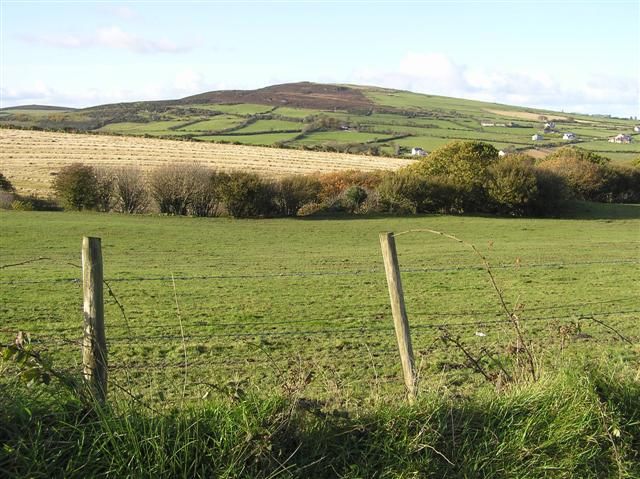One of Derry’s historic place-names is Ballymagroarty – Baile Mhic Robartaigh, the townland of the McGroarty family. The area is named after this herenach clan. In the middle ages, each parish had a herenach family whose duty it was to take charge of and preserve the church relics. In Derry and Drumholme, the McGroarty’s were the herenachs.
One of their most important relics – perhaps the most important of all – was the Cathach, an ancient psalter believed to have been written by Colmcille. It was a copy of the Old Testament psalms, and it was almost unornamented. But this hastily transcribed manuscript was the great saint’s work and so it was treasured for centuries. It had been preserved for about five centuries when a McGroarty called Domhnaill was assigned the task of having a shrine made for it. On the base of the shrine the following message was inscribed: “A prayer for Cathbarr Ua Domhnaill for whom this reliquary was made and for Sitric, grandson of Aedh who made it and for Domhnaill Mhic Robartaigh, coarb of Kells by whom it was made”.
The Cathach gets its name from the Irish word “Cath” which means “a battle.” The book was used as a talisman in battle and it was the duty of the McGroarty herenach to carry it in the field when the O’Donnell fought.
There is also an old tradition that the McGroartys used the Cathach at the O’Donnell inauguration ceremonies, when the new chief swore on the book and held a stick of willow in his hand.
The McGroarty’s remained the custodians of this important book for centuries but eventually the O’Donnell family themselves took charge of it. It was later to be taken abroad and then returned to Ireland. Over the centuries, it was encased in a few different shrines, which were either replaced or repaired when the need arose.
Domhnaill Mac Robartaigh, the coarb of Kells, the man who was responsible for the making of one of the shrines lived in the 11th century. A contemporary of his was a very famous Mac Robartaigh – Muredach, who was born in Donegal in the year 1028. Known on the continent as Marianus Scotus, he founded the Irish convent of Ratisbon. He left Ireland when he was 28 and went to Germany, where he settled as a monk in Cologne for three years. Then he was ordained and spent ten years in the Abbey of Fuld. He died at Mentz when he was 58. Continental writers have mentioned his great sanctity and stated that he was the most learned man of his time, and that he had deep knowledge of the sacred scriptures, history, calculations and all the sciences.
Like Colmcille, Muredach Mac Robartaigh left an interesting book. One of his works, a copy of St. Paul’s epistles, is preserved in Vienna. It is illustrated with notes in the margins and at the end by “Marianus Scotus” he wrote his Irish name and jotted a note that he had written it for the use of Irish pilgrims and travellers – his brethren travelling abroad.
Today’s McGroartys can be very proud of their herenach ancestors who for centuries protected the Cathach. to their safe-keeping of it, this work of Colmcille’s survived to this day.


Also see:
https://mcgroarty.org/countries/ireland/kings-of-ireland-mcgroarty-family-history/
https://www.townlands.ie/londonderry/north-west-liberties-of-londonderry/templemore/liberties-lower/ballymagroarty/
Researching McCollum (McCallum). Have a Edward McCollum baptized or born in Ballintra Ireland 1810 (we think). His mother was a Ellen Dougherty (we guess born about 1790ish) we believe we found her grave at the Long Tower in Derry (McCollum plot; first marker near heritage center entrance) Edward noted on his marriage or death record he was from Groarty. I found a Groarty road out of Derry to the border and a historical B&B called the Groarty house; but no town or county called Groarty. I am thinking maybe he shorted Ballyamgroarty to Groarty?
Next, Bishop John Keys Dogherty of the Long Tower (1900s) his family links to Ballymagroarty. It is stated in our family history that we McCollum’s have a connection to the family that issued in the Cardinal Dennis Joseph Dougherty of Philly (1930s). I am guessing!, ha,ha, that maybe our Ellen Dougherty may be related to the Doherty’s of Ballymagroarty and that the Bishop goes back to the Cardinal’s family, which I think it does.
If you have read this far… ha,ha,… how can I find if there was a McCollum’s listed in births or deaths in the Ballymagroarty area?
Thanks for you patience!
Richard E. McCallum (USA)